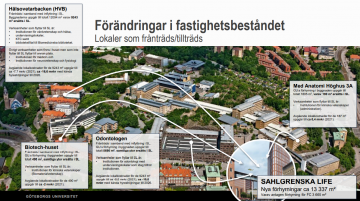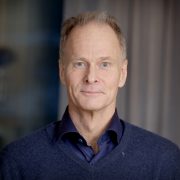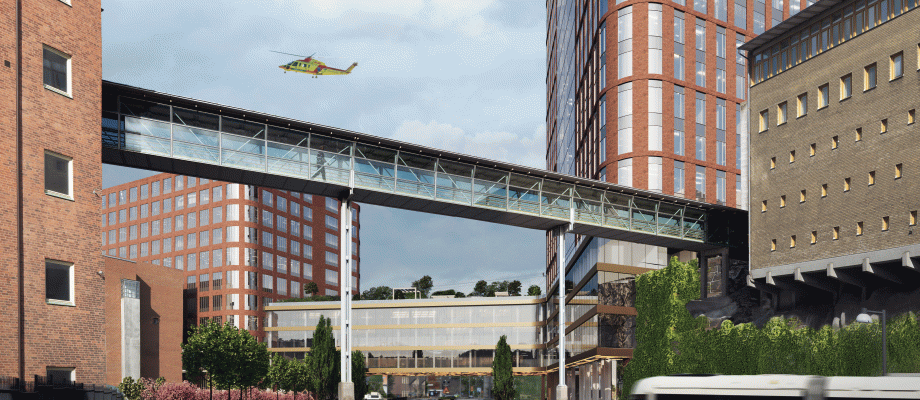SAHLGRENSKA LIFE. At Campus Medicinareberget, the Sahlgrenska Life program review has now been completed. It clarifies how large an area the University of Gothenburg plans to rent, and which existing premises it will be vacating. According to the forecast, the estimated rise in premises costs associated with the relocation to Sahlgrenska Life, including the new clinical skills center, is approximately 30 percent compared with the costs in 2021. Even without the new premises, the costs of our existing premises would have risen by some 9 percent.
Completion of the program review for buildings 2 and 3 means that the University of Gothenburg and Vitartes, the construction company, are in agreement about taking the project further, into the next phase. In parallel, program work on building 1 is underway under the aegis of Region Västra Götaland (VGR, the County Council). Work on the review has been carried out during the year, engaging many co-workers at Sahlgrenska Academy in the operations concerned. Conclusions of the program review have included a summary of specifications for the departments’ and institutes’ floor space requirements, and clustering of the University’s activities to facilitate the flows within the buildings.
After reviewing the conclusions, the University’s steering group for buildings 2 and 3 has adopted what is known as the “zero document”, a summary of the program review, with the following reservations. First, the Institute of Odontology is to be given the opportunity to review, in terms of its requirements, the premises nominated for it. Second, the new clinical skills center (Färdighetscentrum, FC) will be able to review its allocated floor space and discuss distribution among uses with VGR.
Concentration of Sahlgrenska Academy at fewer addresses

The University plans to lease the whole of levels 7, 15 and 16, along with parts of levels 99, 5, 6, 13, 14 & 21 (see illustration) when Sahlgrenska Life is ready for the tenants to move in. The new clinical skills center, which is a resource we shall share with VGR, has been placed on levels 17–19, where additional space preliminarily measuring 3,665 m2 will be made available. For the new clinical skills center, discussions are taking place with VGR on floor space, terms and conditions for leasing, and the distribution of costs between the University and VGR.
Sahlgrenska Academy is leaving all the premises that it has leased to date from the municipal real estate company Higab, recently sold to Platzer Fastigheter: the Institute of Odontology, Hälsovetarbacken and the Biotech Center.
All current activities in the Institute of Odontology will be relocated in Sahlgrenska Life building 3, and the preliminary plan is for it to occupy the whole of level 15 but also parts of levels 13–14, which will be shared with Swedish Public Dental Care.
Accordingly, the University will not lease any premises at Hälsovetarbacken in the future either. The Institute of Health and Care Sciences is currently located there, with training premises and the Clinical Training Center. These will move to level 1 in Sahlgrenska Life building 3. There, they will be joined by the administrative section at the Institute of Clinical Sciences, which is currently located in the high-rise Anatomy building at Medicinaregatan 3A.
The branch of the Biomedical Library at Hälsovetarbacken will use part of level 7 in building 3.
Not everyone currently working at Hälsovetarbacken, however, will move to Sahlgrenska Life. Minor parts of the Institute of Medicine and the Institute of Neuroscience and Physiology will be relocated in other premises.
At present, the Biotech Center houses the Department of Biomaterials at the Institute of Clinical Sciences. These, too, will move to Sahlgrenska Life.
Rent, running costs and depreciation included in costs of premises

Premises costs comprise various parts. What is referred to in the calculations as “external rent” is what we pay to the landlord. In addition, there are running (operating) and heating costs, and depreciation. After all major renovations or new construction, a period of raised costs follows until the depreciation costs cease, which commonly occurs after some ten years.
The cost is heavily influenced by the contents of a building. One that is intended for offices only is cheaper to build than a technology-intensive block with advanced laboratory environments. Sahlgrenska Life buildings 2 and 3, where the University is to lease premises, are office buildings that can also contain laboratories.
Decrease in total floor space
The Faculty’s total area will be smaller, but has been enlarged slightly since the program review compared with the area specified in the original program report. The total area that the University intends to rent in Sahlgrenska Life is 9,672 m2. For the new clinical skills center, which is a resource we will share with Region Västra Götaland (VGR), floor space that the university will rent will be added but there are ongoing discussions about areas and cost distribution.
During work on the program review, the floor space for laboratory premises has increased by 1,500 m2, while premises for offices and libraries have decreased. This is a factor causing a higher external rent, since premises containing labs are more expensive.
Today, the units in Sahlgrenska Academy that are planning to move to Sahlgrenska Life have 14,440 m2 altogether at their disposal. The total floor space of premises at Sahlgrenska Academy (including the Biomedical Library) will be reduced, after the move to Sahlgrenska Life, from approximately 63,200 m2 to roughly 60,400 m2 (2,850 m2, or 4.5 percent, smaller). If the preliminary floor space we plan to rent is excluded, the reduction is instead 4770 m2 .
Sahlgrenska Life (including the new clinical skills center) is expected to cause the costs of the Faculty’s premises to rise by some 30 percent compared with 2021, from SEK 134 million to approximately SEK 174m annually, and thereafter fall to some SEK 163m a year in the period before the depreciation costs come to an end.
Raised premises costs for Faculty
The rental discounts that the University has enjoyed for its premises in Hälsovetarbacken, the Institute of Odontology and the Biotech Center are to be phased out. This will entail a 9 percent increase in the Faculty’s costs of existing premises up to 2026, without any improvements being made in the premises.
Approval of the zero document from the program review is the basis for the next stage in the construction process, termed the “system phase”. The aim for this phase is to produce a practical proposal for a functional building. The comments received from the institutes and departments during the review of the zero document have, in some cases, been incorporated into the final zero document, while it is expected that others can be dealt with during the system phase.
During the system phase, the relocations developed during the program review are refined further. The system phase is expected to take about a year and will culminate in a draft lease agreement.

Eric Hanse, Vice-Dean for Premises and Infrastructure, looks ahead.
“Now the departments and institutes are going ahead with the local premises planning. As for the management, we’ll work to ensure that our premises are fit for purpose in the future and help us to develop. Development requires investment, but our costs of premises also need to be manageable. Historically, the Faculty has had relatively low premises costs. We’ve long known that any change, both new construction and refurbishing of existing buildings, will mean a significant increase in these costs. That’s why the Sahlgrenska Academy have added a finance committee to support us in the project organization, and they’ve actively participated in reviewing the zero document.
“The new premises we’re now investing in,” he continues, “will serve us well for many years to come, and one big challenge will be to anticipate what the requirements will be like over time. So it’s important to create premises that are flexible enough to be modified when needs change, and to avoid doing expensive renovations unnecessarily.”
More information
The other project partners’ work is continuing. In December, the detail plan for the area is expected to be tabled for decision in the City of Gothenburg’s municipal council.
- Link to the City of Gothenburg website for more information about the local planning process
- City of Gothenburg’s brief update on the project (in Swedish)
BY HELEN EASTERLING











